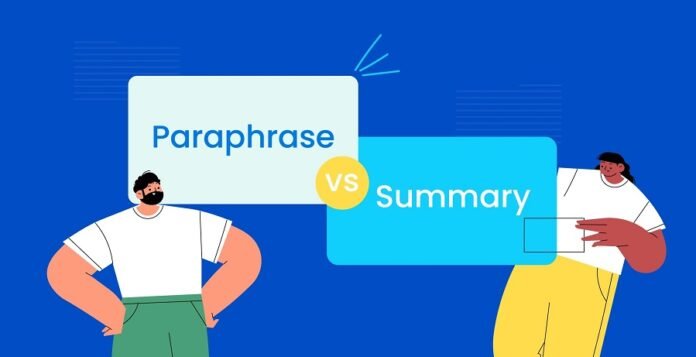When it comes to handling information and text, whether in academic writing, content creation, or research, two techniques often come into play: paraphrasing and summarizing. These are valuable skills that help writers convey information effectively while avoiding plagiarism and maintaining clarity. However, understanding the key differences between paraphrasing and summarizing is crucial. In this comprehensive guide, we will explore the distinctions between these two techniques and when to use each one effectively.
The Importance of Paraphrasing and Summarizing
Paraphrasing and summarizing are indispensable skills in academia, journalism, research, and content creation. These techniques allow writers to present information in a clear and concise manner, making complex ideas accessible to a broader audience.
Why Knowing the Difference Matters
Understanding the differences between paraphrasing and summarizer is vital for effective communication. Using the wrong technique can result in miscommunication or even unintentional plagiarism. Let’s delve into the distinctions between these two methods.
What Is Paraphrasing?
Definition of Paraphrasing
Paraphrasing involves rephrasing a passage or text while retaining its original meaning. In essence, it’s rewriting someone else’s words in your own words. This technique is used when you want to present the same ideas as the original text but in a different way.
When to Use Paraphrasing
– When you need to explain a complex concept more clearly.
– When you want to avoid quoting excessively from a source.
– When you want to provide alternative phrasing to enhance understanding.
Examples of Paraphrasing
Original Text: “The Earth’s climate is experiencing rapid changes due to human activities, leading to global warming and its dire consequences.”
Paraphrase: “Human actions are causing swift alterations in the Earth’s climate, resulting in global warming and its severe repercussions.”
What Is Summarizing?
Definition of Summarizing
Summarizing involves condensing the main points and key details of a text while omitting less important information. The goal is to provide a concise overview of the source material, capturing its essence without the need for a full reading.
When to Use Summarizer
– When you want to provide an overview of a lengthy document or article.
– When you need to distill the main ideas and key findings from a complex source.
– When you want to offer readers a quick understanding of a topic.
Examples of Summarizing
Original Text: “In his groundbreaking research, Dr. Smith conducted a series of experiments that conclusively proved the existence of dark matter in the universe. His findings shed light on the fundamental structure of the cosmos.”
Summary: “Dr. Smith’s pioneering research confirmed the presence of dark matter in the universe, offering valuable insights into the cosmos’ fundamental structure.”
Key Differences Between Paraphrasing and Summarizing
Retaining vs. Condensing Information
Paraphrasing retains most of the original text’s information while rewording it. Summarizing, on the other hand, condenses the information significantly, highlighting only the key points.
Length of the Text
Paraphrased text is typically of a similar length to the original, while summaries are notably shorter, sometimes only a fraction of the original length.
Level of Detail
Paraphrasing maintains the same level of detail as the source material, whereas summarizing simplifies complex information by presenting only the essential elements.
Writing Style
Paraphrasing often involves using synonyms and rephrasing sentences, maintaining a writing style similar to the original. Summarizing requires rewriting in a more concise, informative style.
Why Accuracy Matters
Avoiding Plagiarism
Both paraphrasing and summarizing are essential for avoiding plagiarism. Without proper attribution or if done inaccurately, using someone else’s work, even in a paraphrased or summarized form, can lead to ethical and legal issues.
Maintaining Original Meaning
Whether paraphrasing or summarizing, it’s crucial to retain the original meaning and intent of the source material. Distorting or misrepresenting the information can lead to misunderstandings.
When to Choose Paraphrasing
Complex Texts
Paraphrasing is ideal for complex texts where preserving the original language and detail is essential for a thorough understanding.
Preserving Details
If you need to retain specific details, examples, or nuances from the original text, paraphrasing allows you to do so while presenting the information in a different way.
Providing Multiple Viewpoints
Paraphrasing can be useful when you want to offer various perspectives on a topic by presenting the same information in different words.
When to Choose Summarizer tool
Lengthy Texts
Summarizing is particularly valuable when dealing with lengthy documents or articles, allowing you to provide readers with a quick overview without overwhelming them with details.
Simplifying Complex Information
When the source material contains complex concepts or technical jargon, summarizing can simplify the content and make it more accessible to a broader audience.
Highlighting Main Points
Summarizing is ideal when you want to emphasize the primary ideas, key findings, or the most critical aspects of a text.
Challenges in Paraphrasing and Summarizing
Finding Synonyms
Paraphrasing can be challenging when it comes to finding suitable synonyms for certain words or phrases without altering the original meaning.
Avoiding Bias
Maintaining objectivity and avoiding unintentional bias while paraphrasing or summarizing can be difficult, as the choice of words can influence the tone of the content.
Balancing Conciseness
In summarizing, achieving the right balance between brevity and clarity can be tricky. Omitting too much information may result in an incomplete summary, while including too many details
defeats the purpose of summarization.
Practical Tips for Effective Paraphrasing and Summarizing
Understanding the Source Material
Before paraphrasing or summarizing, thoroughly read and understand the source material to grasp its main ideas, tone, and nuances.
Utilizing Paraphrasing Tools
Consider using paraphrasing tools or software to assist in the process, but always review the output for accuracy and clarity.
The Importance of Editing
Whether you choose touse paraphrasing tool or summarize manually or with the help of tools, always edit and revise your work to ensure it accurately represents the source material and maintains readability.
Conclusion: Mastering the Art of Paraphrasing and Summarizing
In the realm of effective communication and information sharing, mastering the art of paraphrasing and summarizing is a valuable skill. By understanding the differences between these techniques and when to use each one, writers can convey ideas more clearly, avoid plagiarism, and cater to the specific needs of their audience.
Recognizing the context and purpose of your writing will guide you in choosing between paraphrasing and summarizing. With practice and attention to detail, you can enhance your writing skills and become a more effective communicator in various fields, from academia to journalism and beyond.



































































